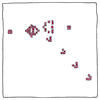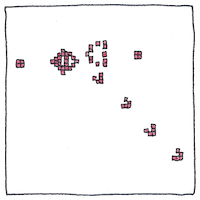John Horton Conway
computer science

|
Conway’s Game of Life
Each square of this two-dimensional universe can be born, live, or die. With exactly three neighbors, it’s born. With two or three neighbors, it lives. With fewer than two or more than three, it dies. As their god, you scatter living squares and then you watch them die, live, and be born in interesting and unpredictable patterns.
Variations of life
Patterns may persist without changing, may oscillate, and may move through space. An oscillator may have a period of 2 or more. A pattern that grows may stabilize, may eventually die out altogether, or may grow without limit. It may begin to repeat itself after many iterations, or it may remain chaotic indefinitely. Many variations explore different rules, cells having different states, shapes, or colors, and living in different spaces.
Inherently interesting
I have said interest is an emotional response to the recognition of hidden similarities and differences presented by either juxtaposition or implication. A dynamic system, natural or artificial, is inherently interesting if it’s unpredictable. We think we’re not unpredictable, but maybe we are.



John von Newmann’s criteria for life is (1) that it can reproduce itself, and (2) that it can simulate a Turing machine.
To say that Conway’s Game of Life meets John von Newmann’s first criterion is incorrect, since a cell does not reproduce itself. Conway prototyped the game using a Go board with its black and white stones. Typically today, a computer represents a cell internally and projects it on its screen as a square. But we can say that Conway’s Game of Life simulates this criterion, and that it can meet von Newmann’s second criterion, since it has the ability to act as a universal Turning machine.
Another definition of life might require that each cell consume a portion of some finite renewable environmental resource to survive. Life might be required to have evolved as part of a natural ecosystem. Conway’s Game of Life is, instead, a kind of “artificial life.”
See also in The book of science:
Readings in wikipedia:
Other readings: